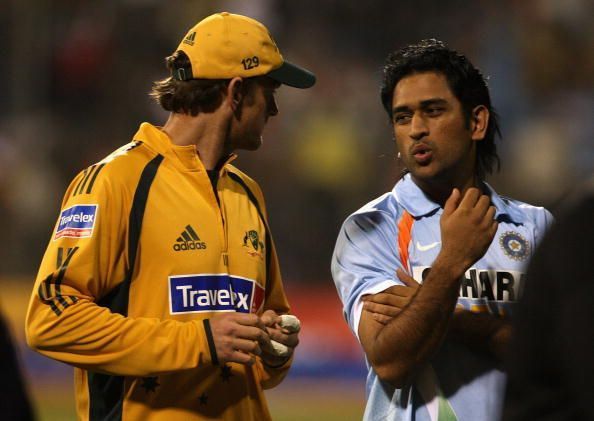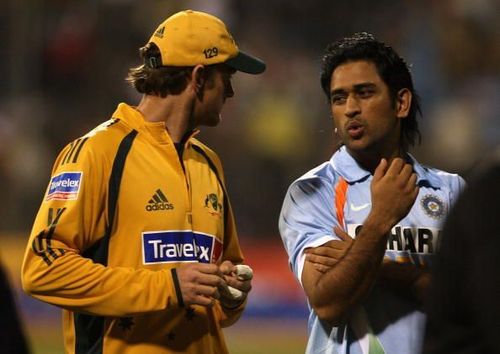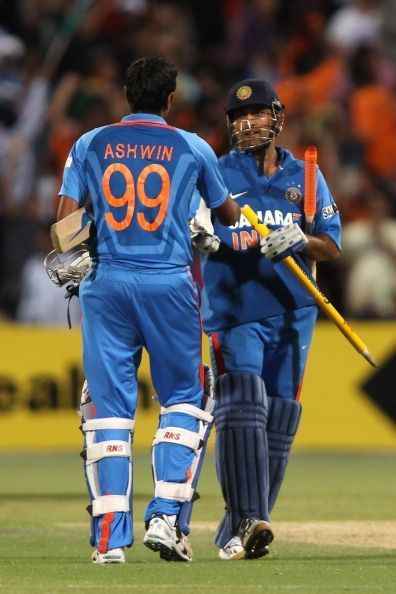
A decade since MS Dhoni commenced a historic journey as ODI captain

“What do you think went wrong?”
“Apart from the toss, everything went wrong.”
After hosts India crumbled for 148 on a batting beauty at Vadodara in October 2007, a keen journalist posed a straightforward question that had an obvious answer to their newly appointed ODI captain MS Dhoni, who replied with a childish smile so wide as if to indicate he had never encountered an easier question in life.
Mitchell Johnson had ripped apart the same batting line-up which had piled on 291 at Chandigarh just three days back and scripted a rare win against Australia – India had last defeated them in an ODI as far back as January 2004 – and a captain boasting of the most unlikely of global triumphs just weeks back was left shame-faced.
Still fresh from the glory of lifting the inaugural ICC World T20 in South Africa, Dhoni and his young T20 troop, most of whom were part of the squad for the Australia series, were brought back to earth after inflicting an upset in the match before. Eventually, the series ended 4-2 in favour of the visitors, but not before a spirited India, under a freshly appointed skipper, had suggested that the World T20 win was no fluke.
The next ODI series that India played did not feature Rahul Dravid – most importantly, for Dhoni’s fans, his endearing, long locks had vanished as well – while the one that followed had even Sourav Ganguly missing, perhaps the first signs from a confident captain that he was firm on building a team on young legs alone, particularly after a harrowing outing at the 2007 World Cup of which Dhoni was himself a part, and where India, despite having veterans in the team, had failed to advance to the Super Eight stage.
A bunch comprising merely Sachin Tendulkar, Virender Sehwag, Yuvraj Singh and Dhoni himself among experienced names brought home the prestigious CB series trophy from Australia in 2008, where names like Ricky Ponting, Adam Gilchrist, Matthew Hayden and Brett Lee were dealt a severe blow by memorable contributions from the then unknown Ishant Sharma, Rohit Sharma and Praveen Kumar.
A foundation stone had been laid which acted as a massive step forward in the right direction, thus propelling a sense of optimism into a unit which would go on to script multiple major ODI victories in the times to come.
Their leader would soon acquire the tag of “Captain Cool” for his impressively composed approach to both batting as well as captaincy, the former elevating him to the level of a highly revered ODI finisher, while the latter helped ease nerves even in tense matches and thrilling conclusions.
India commenced a journey under an idiosyncratic Dhoni, who would create history with both the team's as well as individual performances. Decisions to allow his colleagues to lift the trophy of any bilateral and tri-lateral series instead of stepping forward to do it himself went a long way in defining the character which a humble Dhoni possessed; in just his third Test in-charge, he handed over the captaincy to his former skipper and the retiring Ganguly for the final five overs of the Nagpur Test against Australia in 2008, a surprising maturity in a new captain.
All possible limited-overs trophies came India’s way, with the cabinet starting to fill up fast, starting with the Asia Cup win in Sri Lanka in 2010 following the CB series two years earlier; and what joined them in 2011 was the most coveted piece of ODI silverware – the World Cup! In the final, an out of form Dhoni gambled by promoting himself ahead of the hero of the tournament Yuvraj, and the move expectedly bore fruit.
He hoicked a six over long-on to smash the winning runs and remained unbeaten on 91, thus becoming only the second Indian captain to win the World Cup, which India had last won 28 years ago.
If critics believed that that was a relatively comfortable ride, considering India were the hosts, Dhoni and company added the ICC Champions Trophy held in England to the list in 2013. A tournament sans Tendulkar, Yuvraj, Sehwag, Zaheer Khan and Gautam Gambhir, who had played a defining role in both of India’s global wins, and all of whom were part of the successful World Cup campaign in 2011, saw the rise of the dominating opening pair of Rohit and Shikhar Dhawan, besides the emergence of Bhuvneshwar Kumar as a potent new ball bowler.

Dhoni emulated the great Ricky Ponting in bagging the World Cup as well as the Champions Trophy inside two years, with Australia, under Ponting, having lifted the 2007 World Cup and then the 2009 Champions Trophy – though they had also won the Champions Trophy in 2006 under Ponting.
But Dhoni was walking towards greatness in his own swift way, with the comparison between both former captains refusing to end there. While playing Zimbabwe in a T20 in 2016, Dhoni equaled Ponting’s record for the most matches as captain across all three formats, a feat which he would soon make his own following another seven games as the skipper.
While Ponting ended his tenure as captain following 324 matches in command after Australia lost to India – led by Dhoni – in the quarter-final of the 2011 World Cup, Dhoni resigned as captain in January 2017, his final series coming against New Zealand at home during October 2016. In total, he finished with 331 games as captain.

Though Ponting boasted of an overall win percentage much higher than Dhoni, a major reason for the same was the strong team Ponting led for most of his career, which included ferocious cricketers like Hayden, Gilchrist, Glenn McGrath and Shane Warne, among others.
As far as ODI cricket is concerned, Dhoni fell one short of 200 matches. Ponting, who was captain from 2002 to 2011, was Australia’s skipper in 230 ODIs, and led them in four consecutive Champions Trophy tournaments from 2002 and three successive World Cups from 2003. Yet again, though Ponting edges out Dhoni in terms of win percentage, nothing can be taken away from the latter for his leadership skills.

Now comes personal performance. While Dhoni started his career batting at number seven before gradually moving up to occupy all slots from number three to six, including eight – he even opened twice – Ponting, being Australia’s best batsman of his era, batted at three irrespective of the format; in ODIs, 330 of Ponting’s 365 innings came at that position.
Also, a huge quality which defined Dhoni was his selflessness when it came to personal milestones. Someone who piled up great knocks and fashioned numerous fantastic wins from the number four and five positions, Dhoni opted to play the role of a finisher once the baton was passed on to him from Dravid. He fixed himself at number six while quietly allowing the likes of Virat Kohli, Yuvraj and Suresh Raina to flourish inside the top five. Experts often questioned Dhoni’s move but he seldom tweaked the batting order in his favour. With Dhawan and Rohit consolidating at the top and Kohli rapidly rising at three with every passing match, Dhoni was content to bat at six.
His responsibility of ensuring India crossed the line despite taking it deep into a run chase paid dividends almost every time, and examples lie in his innings against Australia at Adelaide in 2012 – where a late, monstrous six off Clint McKay and an exciting last over finish bewildered the opposition – and a single-handed last-ditch effort to edge past the paltry Sri Lankan total of 201 at Port-of-Spain in 2013 – with 14 required off 6 and India nine down, Dhoni demolished Shaminda Eranga with sixteen off four balls, consisting of two sixes and a four – established Dhoni’s greatness.

Sacrificing big scores and hundreds – at number six, he would naturally face fewer balls than Ponting did at three – Dhoni still accumulated 5,099 runs batting at five and six; while Ponting hit 22 centuries as ODI captain to Dhoni’s 6, the number of fifties by the former Australia stalwart remains just four more having batted 49 times more as skipper.

Humble moves like calling upon Kohli to lift the tri-series trophy in West Indies in 2013 – whose final was won by clobbering Eranga – where Kohli had stood-in for three group games after Dhoni pulled his hamstring while batting in the first match made Dhoni stand apart; and in the semi-final of the 2014 World T20, he let go of the opportunity to score the winning runs by defending astutely, instead allowing Kohli, who was unbeaten on 68, to do the same.
Feats such as becoming only the fifth Indian to 300 ODIs and snatching the record of remaining unbeaten most times in ODIs, which, incidentally, occurred in his 300th match, continued to come his way after relinquishing the captaincy.
Dhoni matured as a captain with time and experience, facing tough questions with elan from the public and the media alike; he ridiculed a journalist who tried to enquire if Dhoni would be retiring post India’s loss in the semi-final of the World T20 in 2016.
The once smiling captain, who spoke with a youthful, broad grin to a reporter in Vadodara in 2007 slowly and steadily transformed himself into a mature and learned ODI captain and batsman, ruling millions of hearts during nine years of captaincy, a post he enjoyed to the fullest after starting out on 29th September 2007.